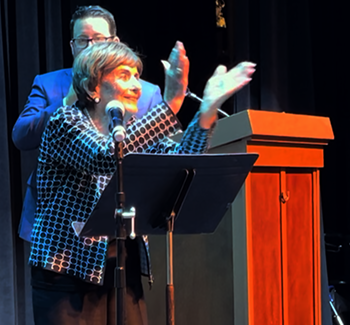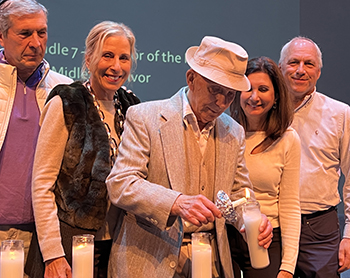By Donald H. Harrison


LA JOLLA, California – There was no mention of it on the printed program for the community commemoration of Yom HaShoah on Sunday, April 16, but Darren Schwartz, the chief planning officer of the sponsoring Jewish Federation of San Diego, explained it as follows:
“We are welcoming Fanny Krasner Lebovits up to the stage again. When a 100-year-old Survivor says that she would like to sing, she sings!.”
And that’s exactly what Lebovits did, first in Yiddish with a version of Eli, Eli (My God! My God!) and then in English with “Tell Me Where Can I Go?” As a finale, Lebovits recited Shaul Tcerhnichovsky’s poem “Laugh, Laugh At All My Dreams!”
The hundreds of attendees at the Lawrence Family Jewish Community Center loved every minute of it, giving Lebovits a standing ovation. How many times in our lives will we get to hear a centenarian who survived the Holocaust providing a mini-concert?
A translation of Eli, Eli, found on line, reads in part:
In fire and flame have men been tortured
And everywhere we went we shunned and ridiculed
No one could make us turn away from our faith
From you, my God, from your holy Torah, your law!
The song was composed approximately at the time of World War I. It was performed by Cantor Josef Rosenblatt in 1917 and became further popularized when African-Americans adopted it as their own. Duke Ellington’s band played a version of it. Johnny Mathis movingly sang it.
The second song Lebovits sang achingly describes the plight of people seeking to avoid the Holocaust, but who were turned away at every turn:
Tell me where can I go?
There is no place I can see
Where to go, where to go”
Every door is closed to me,
To the left and to the right,
It’s the same in every land,
There’s no place to go
And it’s me who should know,
Won’t you understand?
The second stanza is an expression of hope, in contrast to the first stanza.
Now I know where to go
Where my folks proudly stand.
Yes I know where to go.
Let me go, let me go
To that precious promised land,
to the left and to the right,
Lift your head and see the light,
I am proud, can’t you see?
No more wandering for me,
For at last I am free.
No wandering for me,
I am free.
Similarly, the last stanza of Tchernichovsky’s poem declares:
And in the future I still believe
Though it be distant, come it will
When nations shall each other bless
And peace at last the earth shall fill.”

Lebovitz, who authored the memoir Memories, Miracles, and Meaning: Insights of a Holocaust Survivor was among Holocaust Survivors who each lit a candle memorializing the Six Million Jews killed in the Holocaust. Other Survivors given the honor were Adele Beim; Ilona Medvied; Manya & Mike Wallenfels togethera; Anita Fuchs, and Lou Pechi. Ben Midler lit a special seventh candle in honor of the New Life Club of Holocaust Survivors, an organization that celebrates its 70th anniversary this year.
An instrumental version of the Holocaust standard, Ani Ma’amin (I Believe), was performed by a string quartet comprised of Marcia Bookstein, Eileen Wingard, Myla Wingard and Dorothy Zeavin as a prelude to a video remembrance of those Survivors who had died since last year’s Yom HaShoah commemoration. Following the candle lighting ceremony, Rabbi Mendel Polichenco of Chabad of Carmel Valley chanted the memorial prayer El Moleh Rachamim (“God Full of Compassion”). Midler then recited the Mourner’s Kaddish, which glorifies and sanctifies God’s name.
Sandy Scheller, daughter of the late Holocaust Survivors Kurt and Ruth Sax and curator of the upcoming year-long Holocaust exhibit at the Rancho San Diego Branch of the County Public Library, showed a video recalling the lives and smiles of Survivors who had settled in San Diego County. After that, Midler, representing the First Generation of Survivors, and Scheller, Joe Fox, Sonia Fox Ohlbaum, Jack Morgenstern, and event chair Barbara Ostroff representing the Second Generation, reminisced in a panel discussion about life in various venues of San Diego County and their memories of the New Life Club. This writer offered a brief presentation on the history of Survivors in San Diego County, which will be published on this website tomorrow.
Other highlights included a Presentation of the Colors by a unit from the Marine Corps Recruit Depot; the singing of the U.S. National Anthem by Sophia Hughes, and at the conclusion of the program, the singing of Hatikvah by Lily Johnson. Both Hughes and Johnson are members of the JCompany Youth Theatre.
Vera Lovell, the current president of the New Life Club, extended a welcome to the hundreds of attendees. Jewish Federation of San Diego County President and CEO Heidi Gantwerk, in a video message, said “it’s time” for the community to move onto the next phase of Holocaust education, perhaps presaging a permanent Holocaust museum or study center somewhere in the county. The Federation’s Darren Schwartz served as an emcee of the event.
*
Donald H. Harrison is editor emeritus of San Diego Jewish World. He may be contacted via donald.harrison@sdjewishworld.com
Pingback: Three-Part Series to Feature Recorded Music From the Holocaust - San Diego Jewish World
Don, you’ve done it again! Mazel Tov on a beautiful piece that so rightfully honors those before us, and those still here who shared their stories so that we may never forget! I hope you are well and send my best always,
Pam
Pingback: Yom HaShoah Observances Held Throughout San Diego County - San Diego Jewish World
Pingback: A Short History of Holocaust Survivors in San Diego - San Diego Jewish World
What an excellent summary of the event. Outstanding was the history of the New Life Club in San Diego, well-reasearched
and beautifully delivered by the author, Don Harrison.
Thank you Eileen. The performance of your string quartet of Ani Ma’anim was beautifully moving.
Oh my gosh, Eileen, you played so beautifully, I was crying……Thank you for the most glorious music.